国际商务英语课文电子版lesson (9)
- 格式:doc
- 大小:38.50 KB
- 文档页数:14

![跨境电子商务英语 Unit 9 课件[56页]](https://uimg.taocdn.com/aa491635daef5ef7bb0d3c65.webp)

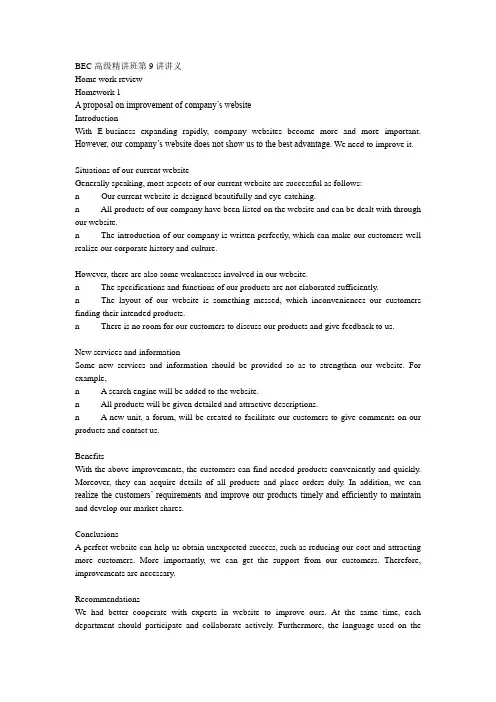
BEC高级精讲班第9讲讲义Home work reviewHomework 1A proposal on improvement of company‟s websiteIntroductionWith E-business expanding rapidly, company websites become more and more important. However, our company‟s website does not show us to the best advantage. We need to improve it.Situations of our current websiteGenerally speaking, most aspects of our current website are successful as follows:n Our current website is designed beautifully and eye-catching.n All products of our company have been listed on the website and can be dealt with through our website.n The introduction of our company is written perfectly, which can make our customers well realize our corporate history and culture.However, there are also some weaknesses involved in our website.n The specifications and functions of our products are not elaborated sufficiently.n The layout of our website is something messed, which inconveniences our customers finding their intended products.n There is no room for our customers to discuss our products and give feedback to us.New services and informationSome new services and information should be provided so as to strengthen our website. For example,n A search engine will be added to the website.n All products will be given detailed and attractive descriptions.n A new unit, a forum, will be created to facilitate our customers to give comments on our products and contact us.BenefitsWith the above improvements, the customers can find needed products conveniently and quickly. Moreover, they can acquire details of all products and place orders duly. In addition, we can realize the customers‟ requirements and improve our products timely and efficiently to maintain and develop our market shares.ConclusionsA perfect website can help us obtain unexpected success, such as reducing our cost and attracting more customers. More importantly, we can get the support from our customers. Therefore, improvements are necessary.RecommendationsWe had better cooperate with experts in website to improve ours. At the same time, each department should participate and collaborate actively. Furthermore, the language used on thewebsite should be concise and exact.Li QingrongManagement DepartmentHomework 2Proposal on Improvement of the websiteIntroductionThis proposal aims to evaluate the strengths and weaknesses of the current website and recommend an improvement plan and elaborate the benefits it will bring.Existing websiteAs a renowned multinational, our company has a beautiful website with a great deal of graphs and pictures. The framework of the website is reasonably designed and it inc ludes almost all necessary aspects.By contrast, the content of the site is not that satisfactory at all. There is only a brief introduction of our company on it without any updated information. Besides, the security of the website also deserves improvement.Improvements to be madeIt has been proved that websites with abundant information and services get more page hits than those which are appearance-oriented. Consequently, the content of the website should be enriched via adding latest news or stories of our company.The security system of the website also needs optimizing so that it can operate normally when suffering virus attack.BenefitsAfter increasing the content of our website, our customers can know more about the company and keep abreast with the latest events. That will definitely enhance their loyalty to our company and will enlarge our customer base at the same time.A more secure system can ensure the safety of the database of the server and also prevent hostile hacking efficiently.ConclusionOur existing website has some defects and need improvement urgently. Appropriate improvements will bring considerable benefits to our company.RecommendationIt is strongly recommended that the content of the website be increased and the security system be optimized.Homework 3Report on improving our websiteThe proposal aims to raise some issues about our website and provide some recommendations to improve it.SituationsThe website of our company was set up in 2000. It has been running for five years. The website showed how our company runs, our mission statement and our structure, to name but a few. It also has a BBS and manager box which improve communications between staff and top leaders effectively. But the homepage of the website needs updating and cannot reflect our company‟s status quo and the development we are making.More informationIn response to the expansion of our company, adding some new information is necessary, such as adding updated news, setting up new database centre, renewal of the web into a more customer-friendly way. A self-service system for customers is also a good idea to improve our customer relationships. The new website should be a centre of company information, and every employee can hear the voice from top leaders through the web. It must be a learning centre from which staff can download the newest technologies and skills to learn. Since our products enter Spain and Japan markets and sales rose dramatically, the Spanish and Japanese versions are also needed.ConclusionsThe improvement of our website will give both company and staff stronger backup, and raise the productivity. The multi-language versions website will be more effective for our imagination and provide stronger after-sales service for our foreign markets.RecommendationsIt is suggested that the website should be rebuilt as soon as possible. We should hire a professional team to achieve the end.其他观点online service, mailbox for complaintsu 请听一段报纸介绍德国汽车厂商如何通过建立儿童网站获取客户源的报道2.Report On Changes in the sales of product in Japan, Indonesia and France during the period June 1994 to January 1997In June 1994, Japanese sales were $20,000. They fell sharply for twelve months to no sales at all in June 1995, when a new marketing strategy was introduced. Sales rocketed to $90,000 by late 1996.Indonesian sales, in June 1994, were $50,000, and rose steadily to $70,000 in June 1995. Sales dropped slightly to $60,000 in early 1996, but rose again almost to $70,000 by June 1995. Sales dropped slightly to $60,000 in early 1996, but rose once more to $70,000 in January 1997.In June 1994, sales in France were $50,000, but they plunged to $10,000 in January 1996, and varied slightly around $10,000 to January 1997.The new marketing strategy introduced in June 1995 apparently worked well only in Japan.V ocabularystudyII. V ocabulary Study(1) learning words --- 缺少lack noun [singular, uncountable] when there is not enough of something, or none of itᅳsynonym shortagelack ofnew parents suffering from lack of sleepToo many teachers are treated with a lack of respect.comments based on a total lack of informationDoes their apparent lack of progress mean they are not doing their job properly?tours that are cancelled for lack of bookingsThere was no lack of willing helpers.lack verb1 [transitive] to not have something that you need, or not have enough of itAlex's real problem is that he lacks confidence.lacking adjective [not before noun]1 not having enough of something or any of itlacking inHe was lacking in confidence.She seems to be entirely lacking in intelligence.The new designs have all been found lacking in some important way.2 if something that you need or want is lacking, it does not existFinancial backing for the project is still lacking.These qualities are sadly lacking today.Whatmotivesstaff?III. What motivates staff?motivate verb [transitive]1 to be the reason why someone does something促使, 驱使ᅳ同义词driveWould you say that he was motivated solely by a desire for power? 你的意思是说他完全只被追逐权利的愿望驱使着吗?motivate somebody to do somethingWe may never know what motivated him to kill his wife. 是什么驱使他杀了他的妻子, 我们对此不得而知.2 to make someone want to achieve something and make them willing to work hard in order to do this 激励A good teacher has to be able to motivate her students. 一个好教师应该是有能力激励她的学生. motivate somebody to do somethingThe profit-sharing plan is designed to motivate the staff to work hard.这个利润分享计划就是要激励员工勤奋地工作。
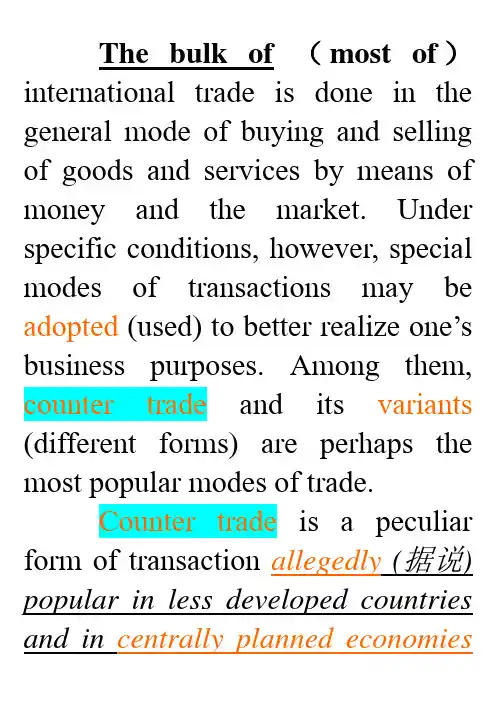
The bulk of (most of)international trade is done in the general mode of buying and selling of goods and services by means of money and the market. Under specific conditions, however, special modes of transactions may be adopted (used) to better realize one’s business purposes. Among them, counter trade and its variants (different forms) are perhaps the most popular modes of trade.Counter trade is a peculiar form of transaction allegedly (据说) popular in less developed countries and in centrally planned economies(中央计划型经济). It has become the generic term to describe a set of cross-border contracts that link a seller’s exports to imports from the buyer, and it is often associated with policy objectives of relevant economies like dealing with foreign exchange shortages and promotion of exports(扩大出口).MethodologyMathematicsphotographThe terminology counter trade employed (used) today can be traced to(date back) the pre-World War II years when normal trade relationswere breaking down (Great Depression). Following German hyperinflation,competitive devaluations (竞争性贬值)and protectionism meant a global collapse in trade and in international financial and banking markets. Unwilling to see Germany cut off from its traditional raw material supplies in the Balkans(巴尔干地区), the Reichsbank agreed to the establishment of a clearing system (清算系统)that settled(结算)only net positions (实际头寸)- and only once a year - a measure that permitted traditional trade flowsbetween Germany and the Balkans to continue. These arrangements were called compensation trade. Another term used in the context of such bilateral clearing operations was “counter trade”. During and after World War II, when financial markets were in disarray(in disorder), Britain used similar bilateral arrangements, as did Western Europe when setting up the European Payment Union. Subsequently (later) the countries of centrally planned economies copied such clearing systems and used them among themselves and also in tradewith neighboring countries like Finland. Conceptually, all these arrangements are trade credit accounts (贸易信贷往来账户) between familiar trading partners exchanging unrelated goods.In the 1970s and 1980s counter trade was different from the old practice although some similarities(likeliness)remained. Current counter trade partners are not necessarily familiar partners and goods exchanged are sometimes vertically related. Current counter trade can be categorized as follows: Barter(易货贸易): The directexchange of goods and services which is completed in a short period of time, e. g., an exchange of frozen lamb from New Zealand for Iran crude oil.Counter purchase(互购贸易;反向购买): The assumption(assume 承担)by an exporter of a transferable obligation through separate but linked contract to accept as full or partial payment goods and services from the importer or importing country. The contract is usually stipulated to be fulfilled within a given period of time, e. g. , 5 years, and the goods or servicesreceived in return are usually pre-specified in a list and are subject to availability and changes made by the original importing country. In essence, then, counter purchase is an inter-temporal direct exchange of goods and services. For example, in 1977 V olkswagen sold 10,000 cars to the former East Germany and agreed to purchase goods from a list set up by the importer over the next 2 years, up to the value of the cars sold to the former East Germany.Buyback:(回购)An agreement by an exporter of plant and equipment(成套装置和设备)to take back in the future part of the output(产品)produced by these goods as full or partial payment. The important difference between counter purchase and buyback is that in buyback the goods and services taken back(buy back)are tied to (捆绑) the original goods exported whereas that is not the case in counter purchase. Another important difference is that a buyback deal usually stretches over (cover; extend 延伸) a longer period of time (as long as 15 to 20 years) than a counter purchase deal. For instance, the Xerox Corporation sold to Chinathe plant and technology for the production of low-volume photocopying machines, and contractually committed to repurchase a very large portion of the photocopy machines produced in the Chinese plant.The intriguing (interesting) features common to barter, counter purchase, and buyback is “bundling (捆绑)”: the exchanges of good s and services are bundled together (the exchanges are implemented either concurrently同时or inter-temporally不同时). In normal market transaction buying andselling of goods and services is unbundled (不捆绑), an arrangement made possible by the use of money and the “market” as an institution (手段). Thus, an individual can sell goods and services to obtain monetary income and can then use the income for other desired goods and services. Such unbundling greatly facilitates(便利;促进)transaction and allows more efficient economic exchanges.While counter trade does not represent an extreme form of bundling, and money as a unit of account(记账单位)is not totallybypassed - in many counter trade deals, only a fraction of (a small part of) the initial (最初的) purchase is paid for in goods and services - the question remains why a significant (quite big)part of the buying and selling of goods and services should be bundled together.The impression one gets is that bundled trade takes place where the market institution(system) is imperfect. It can be said to generally take place between mature market economies and economies with a less sophisticated(mature)market system. Under such circumstancethere are several presumed (被公认的) advantages in counter trade:1.Counter trade is implemented (carry out) because it helps a country to deal with foreign exchange shortages.2.Counter trade can be used to promote exports.3.Counter trade can be used to reduce uncertainty regarding export receipts. (income, earnings)4.Counter trade is used to bypas s (避开) an international price agreement like, for example, that of OPEC (cartel).5.Counter trade may help thosenations with serious debt problems (debtor nation 债务国)to continue to import goods while, in effect, conceal ing (隐瞒) export earnings from creditors (债权人).However, counter trade can be very risky business. By conceal ing the real prices and costs of transactions it may conceal and help perpetuate(使永久存在)economic inefficiencies in the market place. Companies may suffer losses because they could not get rid of (sell)products of poor quality. Finally, counter trade may be considered as a form ofprotectionism.Among other modes of trade are processing trade, consignment, leasing trade, agency etc.。
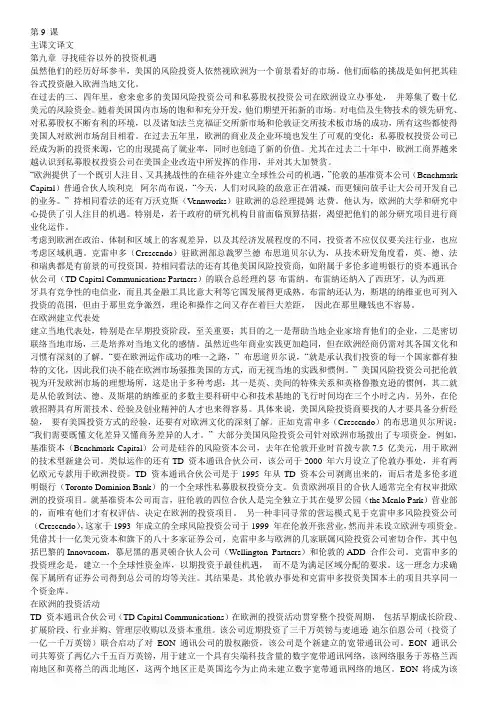
第9 课主课文译文第九章寻找硅谷以外的投资机遇虽然他们的经历好坏参半,美国的风险投资人依然视欧洲为一个前景看好的市场。
他们面临的挑战是如何把其硅谷式投资融入欧洲当地文化。
在过去的三、四年里,愈来愈多的美国风险投资公司和私募股权投资公司在欧洲设立办事处,并筹集了数十亿美元的风险资金。
随着美国国内市场的饱和和充分开发,他们期望开拓新的市场。
对电信及生物技术的领先研究、对私募股权不断有利的环境,以及诸如法兰克福证交所新市场和伦敦证交所技术板市场的成功,所有这些都使得美国人对欧洲市场刮目相看。
在过去五年里,欧洲的商业及企业环境也发生了可观的变化:私募股权投资公司已经成为新的投资来源,它的出现提高了就业率,同时也创造了新的价值。
尤其在过去二十年中,欧洲工商界越来越认识到私募股权投资公司在美国企业改造中所发挥的作用,并对其大加赞赏。
“欧洲提供了一个既引人注目、又具挑战性的在硅谷外建立全球性公司的机遇,”伦敦的基准资本公司(Benchmark Capital)普通合伙人埃利克·阿尔尚布说,“今天,人们对风险的敌意正在消减,而更倾向放手让大公司开发自己的业务。
” 持相同看法的还有万沃克斯(Vennworks)驻欧洲的总经理提姆·达费。
他认为,欧洲的大学和研究中心提供了引人注目的机遇。
特别是,若干政府的研究机构目前面临预算拮据,渴望把他们的部分研究项目进行商业化运作。
考虑到欧洲在政治、体制和区域上的客观差异,以及其经济发展程度的不同,投资者不应仅仅要关注行业,也应考虑区域机遇。
克雷申多(Crescendo)驻欧洲部总裁罗兰德·布思道贝尔认为,从技术研发角度看,英、德、法和瑞典都是有前景的可投资国。
持相同看法的还有其他美国风险投资商,如附属于多伦多道明银行的资本通讯合伙公司(TD Capital Communications Partners)的联合总经理约瑟·布雷纳。
布雷纳还纳入了西班牙,认为西班牙具有竞争性的电信业,而且其金融工具比意大利等它国发展得更成熟。

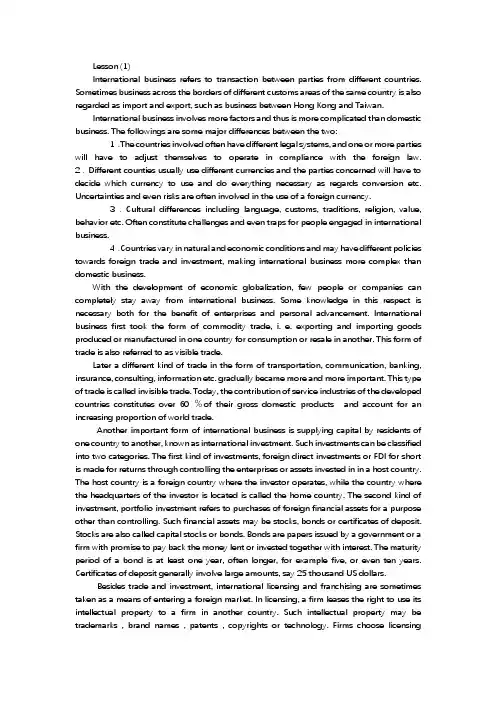
Lesson (1)International business refers to transaction between parties from different countries. Sometimes business across the borders of different customs areas of the same country is also regarded as import and export, such as business between Hong Kong and Taiwan.International business involves more factors and thus is more complicated than domestic business. The followings are some major differences between the two:1.The countries involved often have different legal systems, and one or more parties will have to adjust themselves to operate in compliance with the foreign law. 2.Different counties usually use different currencies and the parties concerned will have to decide which currency to use and do everything necessary as regards conversion etc. Uncertainties and even risks are often involved in the use of a foreign currency.3.Cultural differences including language, customs, traditions, religion, value, behavior etc. Often constitute challenges and even traps for people engaged in international business.4.Countries vary in natural and economic conditions and may have different policies towards foreign trade and investment, making international business more complex than domestic business.With the development of economic globalization, few people or companies can completely stay away from international business. Some knowledge in this respect is necessary both for the benefit of enterprises and personal advancement. International business first took the form of commodity trade, i. e. exporting and importing goods produced or manufactured in one country for consumption or resale in another. This form of trade is also referred to as visible trade.Later a different kind of trade in the form of transportation, communication, banking, insurance, consulting, information etc. gradually became more and more important. This type of trade is called invisible trade. Today, the contribution of service industries of the developed countries constitutes over 60 %of their gross domestic products and account for an increasing proportion of world trade.Another important form of international business is supplying capital by residents of one country to another, known as international investment. Such investments can be classified into two categories. The first kind of investments, foreign direct investments or FDI for short is made for returns through controlling the enterprises or assets invested in in a host country. The host country is a foreign country where the investor operates, while the country where the headquarters of the investor is located is called the home country. The second kind of investment, portfolio investment refers to purchases of foreign financial assets for a purpose other than controlling. Such financial assets may be stocks, bonds or certificates of deposit. Stocks are also called capital stocks or bonds. Bonds are papers issued by a government or a firm with promise to pay back the money lent or invested together with interest. The maturity period of a bond is at least one year, often longer, for example five, or even ten years. Certificates of deposit generally involve large amounts, say 25 thousand US dollars.Besides trade and investment, international licensing and franchising are sometimes taken as a means of entering a foreign market. In licensing, a firm leases the right to use its intellectual property to a firm in another country. Such intellectual property may be trademarks , brand names , patents , copyrights or technology. Firms choose licensingbecause they do not have to make cash payments to start business, and can simply receive income in the form of royalty. Besides, they can benefit from locational advantages of foreign operation without any obligations in ownership or management. The use of licensing is particularly encouraged by high customs duty and non-tariff barriers on the part of the host country. However, it is not advisable to use licensing in countries with weak intellectual property protection since the licensor may have difficulty in enforcing licensing agreement.Franchising can be regarded as a special form of licensing. Under franchising, a firm, called the franchisee, is allowed to operate in the name of another, called the franchiser who provides the former with trademarks, brand names, logos, and operating techniques for royalty. In comparison with the relation between the licenser and the licensee, the franchiser has more control over and provides more support for the franchisee.The franchiser can develop internationally and gain access to useful information about the local market with little risk and cost, and the franchisee can easily get into a business with established products or services. Franchising is fairly popular especially in hotel and restaurant business. Other forms for participating in international business are management contract, contract manufacturing, and turnkey project.Under a management contract, one company offers managerial or other specialized services to another within a particular period for a flat payment or a percentage of the relevant business volume. Sometimes bonuses based on profitability or sales growth are also specialized in management contracts. Government policies often have a lot to do with management contracts. When a government forbids foreign ownership in certain industries it considers to be of strategic importance but lacks the expertise for operation, management contracts may be a practical choice enabling a foreign company to operate in the industry without owning the assets.By contract manufacturing, a firm can concentrate on their strongest part in the value chain, e. g. marketing, while contracting with foreign companies for the manufacture of their products. Such firms can reduce the amount of their resources devoted to manufacture and benefit from location advantages from production in host countries. However, loss of control over the production process may give rise to problems in respect of quality and time of delivery.For an international turnkey project, a firm signs a contract with a foreign purchaser and undertakes all the designing, contracting and facility equipping before handing it over to the latter upon completion. Such projects are often large and complex and take a long period to complete. Payment for a turnkey project may be made at fixed total price or on a cost plus basis. The latter way of payment shifts the burden of possible additional cost over the original budget onto the purchaser.BOT is a popular variant of the turnkey project where B stands for build, O for operate and T for transfer. For a BOT project, a firm operates a facility for a period of time after building it up before finally transferring it to a foreign company. Making profit from operating the project for a period is the major difference between BOT and the common turnkey project. Needless to say, the contractor has to bear the financial and other risks that may occur in the period of operation.Answer the following questions:What does international business refer to? Please tell the difference between international business and domestic business.A:International business refers to transaction between parties from different countries. Sometimes business across the borders of different customs areas of the same country is also regarded as import and export.Some major differences between international business and domestic business is following:Differences in legal systemsDifferences in currenciesDifferences in cultural backgroundDifferent in natural and economic conditionsPlease explain the differences between visible trade and invisible trade. Which is becoming more and more important and accounts for an increasing proportion in international trade?A: Visible trade is the form of commodity trade. The form of transportation, communication, banking, insurance, consulting, information etc. is called invisible trade or service industries. The later is become more and more important.Can you cite some examples to illustrate cultural differences in international business? A: Cultural differences including language, customs, traditions, religion, value, behavior etc. Please elaborate on the two categories of international investment. What is their major difference?A: FDI (Foreign direct investment) is made for returns through controlling the enterprises or assets invested in in a host country. Portfolio investment refers to purchases of foreign financial assets for a purpose other than controlling. Such financial assets may be stocks, bonds or certificates of deposit.What is licensing? Why do firms sometimes choose it as a means of entering a foreign market?A: In licensing, a firm leases the right to use its intellectual property to a firm in another country. They choose licensing because they do not have to make cash payments to stat business, and can simply receive income in the form of royalty. Besides, they can benefit from locational advantages of foreign operation without any obligations in ownership or management. The use of licensing is particularly encouraged by high customs duty and non-tariff barriers on the part of the host country.What is franchising? How is it different from licensing?A: Under franchising, franchisee is allowed to operate in the name of another, franchiser who provides the former with trademarks, brand names, logos and operating techniques for royalty. In comparison with the relation between the licenser and the licensee, the franchiser has more control over and provides more support for the franchisee.What is a management contract? Under what conditions is it most applicable?A: Under a management contract, one company offers managerial or other specialized services to another within a particular period for a flat payment or a percentage of the relevant business volume. When a government forbids foreign ownership in certain industries it considers to be of strategic importance but lacks the expertise for operation, management contracts maybe a practical choice enabling a foreign company to operate in the industry without owning the assets.What is an international turnkey project? In what way is its variant BOT different from it? A: For an international turnkey project, a firm signs a contract with a foreign purchaser and undertakes all the designing, contracting and facility equipping before handing it over to the latter upon completion. For a BOT project, a firm operates a facility for a period of time after building it up before finally transferring it to a foreign company. Making profit from operating the project for a period is the major difference between BOT and the common turnkey project.。
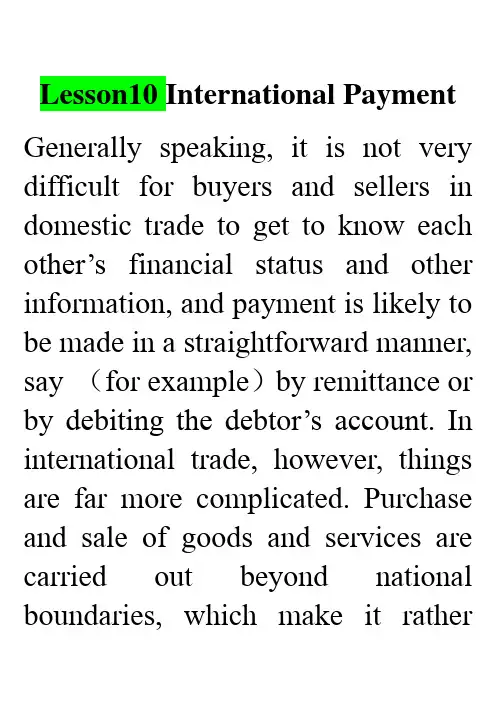
Lesson10 International Payment Generally speaking, it is not very difficult for buyers and sellers in domestic trade to get to know each other’s financial status and other information, and payment is likely to be made in a straightforward manner, say (for example)by remittance or by debiting the debtor’s account. In international trade, however, things are far more complicated. Purchase and sale of goods and services are carried out beyond national boundaries, which make it ratherdifficult for the parties concerned in the transaction to get adequate information about each other’s financial standing and creditworthiness (资信;信誉). Therefore, mutual trust is hard to build. Both the exporter and importer face risks as there is always the possibility that the other party may not fulfill the contract.For the exporter there is the risk of buyer default(不按期付款). The importer might fail to pay in full for the goods. He might go bankrupt.His government might, for various reasons, ban(禁止)trade with the exporting country or ban imports of certain commodities. The buyer might run into difficulties getting the foreign exchange to pay for the goods. It is even possible that the buyer is not reliable and simply refuses to pay the agreed amount on various excuses.On the part of the importer, there is the risk that the shipment will be delayed, and he might only receive them long after payment.The delay may be caused by problems in production or transportation, and such delays may lead to loss of business. There is also a risk that wrong goods might be sent as a result of negligence(疏忽大意)of the exporter or simply because of his lack of integrity (honesty).Political risks such as war, quotas, foreign exchange control; commercial risks like market change and exchange rate fluctuations(波动); and even language barriers all add upto (increase)the problems in international trade. Because of these problems and risks, exporters are hesitant to release their goods before receiving payment, while importers prefer to have control over the goods before parting with their money.Various methods of payment have been developed to cope with different situations in international trade. When the political and economic situation in the importing country makes payment uncertain or when the buyer’s credit standing isdubious (doubtful), the exporter may prefer cash in advance or partial cash in advance. In this case, the importer has no guarantee that the exporter will fulfill his obligations once he has made payment by cash. If the buyer and the seller know each other well, they may decide to trade on open account. This means that no documents are involved and that legally (in terms of law) the buyer can pay anytime. The seller loses all control over the goods once they have been shipped. Sales on thisbasis are usually paid for by periodic payment, and obviously the exporter must have sufficient financial strength经济实力to carry the cost of the goods until receiving payment. If the exporter wishes to retain(保留)title or ownership(所有权)to the goods, he can enter into consignment transactions. This means the exporter has to send his goods abroad and will not get payment until the goods are sold. If not sold, the goods can be shipped back. Therefore, this arrangementshould only be made with full understanding of the risks involved and is preferably to be limited to stable countries where the exporter has a trusted agent to look after his interest.A lot of international transactions are paid for by means of the draft(汇票), which, also referred to as the bill of exchange, is an unconditional(无条件的)order to a bank or a customer to pay a sum of money to someone on demand(立即)or at a fixed time in the future.The person who draws(开立)the draft, usually the exporter, is called the drawer(出票人), and the person to whom the draft is drawn is called the drawee(受票人). There is yet another party payee(收款人), i.e. the person receiving the payment, who and the drawer are generally but not necessarily the same person, as the drawer can instruct the drawee either to pay “to the order of ourselves” or to the order of someone else, for instance, the bank.A draft is either a sight draft ora usance draft (also called tenor draft or term draft). The former calls for (needs)immediate payment on presentation (提示) to the drawee while the latter is payable at a later date, e.g. 30, 45, 60, or 90 days after sight or date. A draft is either clean (clean draft 光票) (without documents) or documentary (documentary draft跟单汇票). In the latter case, the draft is accompanied (attached)by the relevant documents such as the bill of lading, the invoice, the insurance policy etc.In documentary collection ( 跟单托收), the exporter sends the draft and the shipping documents运输单据representing title to the goods to his bank, which forwards (sends) them to anot her bank in the importer’s country, which in turn contacts the customer (importer). In the case of documents against payment (D/P)付款交单, documents will not be released to the importer until payment is effected执行. There are D/P at sight and D/P after sight. The former requires immediate paymentby the importer to get hold of the documents. The latter gives the importer a certain period after presentation of the documents, but documents are not released to him until he actually pays for the merchandise货物. In the case of documents against acceptance (D/A)承兑交单, documents are handed over to the importer upon his acceptance(承兑)of the bill of exchange drawn by the exporter. Payment will not be made until a later date. D/A is always after sight.So far as the exporte r’s interest is concerned, D/P at sight is more favorable than D/P after sight, and D/P is more favorable than D/A. In actual trade, payment by collection should be accepted with discretion (小心). It is usually used when the financial standing of the importer is sound(良好的), or when the exporter wishes to push the sale of his goods, or when the transaction involves only a small quantity. Otherwise, the letter of credit is generally preferred.Lesson 11In international trade it is almost impossible to mach payment with physical delivery (实际交货) of the goods, which constitutes conflicting problems for trade, since the exporter prefers to get paid before releasing the goods and the importer prefers to gain control over the goods before paying the money. The letter of credit is an effective means to solve these problems. Its objectiveis to facilitate international payment by means of the credit-worthiness of the bank. This method of payment offers security to both the seller and the buyer. The former has the security to get paid provided (假如) he presents impeccable(没有缺陷的)documents while the latter has the security to get the goods required through the documents he stipulates in the credit. This bilateral security is the unique and characteristic feature of the letter of credit.“Letter of credit” is often shortenedas L/C or L.C. and is sometimes referred to as “banker’s commercial letter of credit”, “banker’s credit”, “commercial credit” or simply “credit”. Modern credits were introduced 开始采用in the second half of the 19th century and had substantial development after the First World War. The credit is a letter issued by a bank at the request of the importer in which the bank promises to pay upon presentation of the relevant documents. It is actually a conditional bank undertaking(承诺)of payment.The operation of the letter of credit starts with the importer. He instructs his bank to issue an L/C in favor of the seller (以…为收益人)for the amount of the purchase. Here the importer is called the applicant (开证申请人), or opener, principal etc., the bank that issues the credit is called the opening bank, the issuing bank or the establishing bank, (开证行) and the exporter in whose favor the credit is opened is called the beneficiary(受益人). The openingbank sends the credit to its correspondent bank(往来行)in the exporter’s country, who will, after examining(检查)the credit, advise (通知)the exporter of its receipt. Here the correspondent bank is called the advising bank(通知行). The exporter or beneficiary will make a careful examination(仔细检查)of all the contents of the credit and will request the opener to make amendments修改to any discrepancies (不一致)in the credit so as to ensure safe and timelypayment. Sometimes the exporter may require a confirmed letter of credit (保兑信用证) either because the credit amount is too large, or because he does not fully trust the opening bank. The bank that adds its confirmation(保兑)to the credit is called the confirming bank which is undertaken(承担)either by the advising bank or another prime (big)bank. When everything with the credit is in order, the exporter will prepare the relevant documents based on the credit and dispatch thegoods to the importer. Then he will present the draft and the accompanying documents to the advising bank that pays or accepts (承兑) or negotiates(议付)the bill of exchange. The advising bank then also becomes the paying bank which acts as the agent of the opening bank and gets reimbursed(pay back)by the opening bank after paying the beneficiary. If a bank, either nominated (指定)by the opening bank or at its own choice, buys the exporter’s draft submitted to it undera credit, it is called a negotiating bank (议付行). The draft and the documents will then be sent to the opening bank for reimbursement(偿付).Letters of credit are varied in form, length, language, and stipulations. Generally speaking, however, they include the following contents:1. The number of the credit and the place and time of its establishment.2. The type of the credit.3. The contract on which it is based.4. The major parties relevant to thecredit, such as the applicant, opening bank, beneficiary, advising bank. etc.5. The amount or value of the credit.6. The place and date on which the credit expires(失效).7. The description of the goods including name of commodity, quantity, specifications, packing, unit price, price terms, etc.8. Transportation clause(条款)including the port of shipment, the port of destination, the time of shipment, whether allowing partial shipments or transshipment(转船).9. Stipulations relating to the draft.10. Stipulations concerning the shipping documents required.11. Certain special clauses if any.e.g. restrictions on the carrying vessel(承运船只)and the route.12. Instructions to the negotiating bank.13. The seal or signature of the opening bank.14. Whether the credit follows “the uniform customs and practice for documentary credits”.The letter of credit providessecurity to both the exporter and the importer. However, it only assures payment to the beneficiary provided the terms and conditions of the credit are fulfilled. It does not guarantee that the goods purchased will be those invoiced or shipped. It is stipulated in Article 4 of the uniform customs and practice for documentary credit that “in credit operations all parties concerned deal in documents, and not in goods, services and/or other performance to which the documents may relate”.That is to say the banks are only concerned with the documents representing the goods instead of the underlying contracts. They have no legal obligation whether the goods comply with the contract. They will be considered as having fulfilled their responsibility so long as all the documents comply with the stipulations of the credit. The quality and quantity of merchandise shipped, although specified in the documents, ultimately depend on the seller who has manufactured, packaged, andarranged shipment for the goods.If the importer finds any problems with the goods, e.g. inferior quality or insufficient quantity, he has to contact or even take legal action against the exporter instead of the bank so long as the documents are “proper” on their face.Lesson 12Letters of credit fall under several categories depending on their function, form and mechanism. Here are the major types of credit:1. Clean credit and documentary credit: Credits that only require clean draft, i.e. draft not accompanied with shipping documents, for payment are clean credit. They are generally used in non-trade settlement(非贸易结算)or in payment in advance by means of the L/C. Most of the credits used in international trade are documentary credits, i.e. credits that require shipping documents to be presented together with the draft.2.Revocable credit andirrevocable credit: This classification is based on the certainty确信of the commitment 承诺to pay on the part of the applicant and the issuing bank. The credit is a revocable one if such commitments can be altered (改变)or even canceled(取消)without consulting with the beneficiary. It is quite obvious that the exporter has little assurance 保证to get payment, and therefore this type of credits are rarely used. Irrevocable credits are those that cannot be amended (revised修改)or revoked(取消)without the consent(同意)of all the parties concerned. Safe and reliable, this type is extensively(widely)used in world trade. It must be noted that if there is no specific indication whether a credit is revocable or irrevocable, it should be regarded as irrevocable.3. Confirmed credit and unconfirmed credit: If a credit is confirmed by a bank other than (除…之外)the issuing bank, it becomes a confirmed credit. The confirmation is undertaken 承担either by theadvising bank or by another leading bank. Under a confirmed credit, the beneficiary is given double assurance of payment 双重付款担保since the confirming bank has added its own undertaking 承诺to that 承担of the opening bank. If the credit is not confirmed by another bank, it is an unconfirmed letter of credit. Though a confirmed credit is considered to be able to provide the greatest degree of security to the beneficiary, it involves additional cost as a result of the confirmation.Therefore if the establishing bank is a reliable prime bank, confirmation may not be necessary.4. Sight credit and usance credit: A sight credit is one by which payment can be made upon presentation of the draft and impeccable documents by the beneficiary to the bank. It gives the beneficiary better security and helps him speed up his capital turnover. 资金周转Most of China’s export contracts stipulate for sight credit in payment terms. Obviously, a sight credit calls for a sight draft.It is also clear that this type of credit requires a usance draft. If the beneficiary wishes to get payment before the maturity到期of the draft, he can ask the bank to discount贴现the acceptance, and immediately pay him the net proceeds净收益(net position 实际头寸), i. e. the face value 面值of the draft minus减去the discount charges收费.5. Transferable credit andnon-transferable credit: If a credit can be transferred by the original beneficiary to one or more parties, it is a transferable credit. The original beneficiary is called the first beneficiary and the party (or parties) the credit is transferred to is called the second beneficiary. It is usually used when the first beneficiary is a middleman and does not supply the goods himself. A credit can be transferred only once. But transferring a credit to more than one party at the same time is allowedprovided partial shipments are permitted. If a credit does not specify whether it is transferable, it should be regarded as a non-transferable document according to the credit stipulation.6. Non-draft credit: There is a modern tendency for payment to be made by presentation of the documents without the formality of drawing and presenting a draft. Such credits are non-draft credit. They mainly include payment credit and deferred payment credit which arerespectively similar to sight credit and usance credit with the difference that no draft is drawn and presented in the case of non-draft credit.7. Revolving credit: If a credit stipulated that its amount can be renewed更新or reinstated恢复without specific amendment to the credit being made, it is then a revolving credit. It is particularly useful when the buyer and seller have regular trading relationship and deal in a specific quantity of goods each month or any particular periodof time.It has already been mentioned that the letter of credit has greatly facilitated便利and promoted international trade. However, like any other methods (mode) of payment, it is not perfect. It cannot provide absolute security for the contracting parties. The seller may sustain losses 蒙受because of the buyer’s delay even failure in the establishment of credit开立信用证. The buyer may suffer losses as a result of the documents presented bythe seller which do not truly represent the goods shipped. And it is not absolutely avoidable that the bank may become insolvent破产的or bankrupt. Besides, it is more expensive to use the letter of credit than remittance or collection as the bank will charge 收费its client for all the services it provides. So the letter of credit may not be the most ideal(best)method of payment for a particular transaction, and the contracting parties should make their best choice according to the specificconditions.Lesson 13One of the major differences between domestic trade and foreign trade is documentation (单据的使用). Every shipment must be accompanied by a number of correct documents. If they are not the correct ones, the importer will have difficulties in taking delivery of 提货the goods, and delays caused byincorrect documentation may affect future business relations between the trading partners. In the case of documentary letter of credit, any discrepancy不同, even in minor details, between the documents presented and those specified in the credit may lead to refusal by the bank to make payment. Different documents are required for different transactions, depending on the nature of the deal, the term of delivery, the type of commodity, stipulations of credit, regulations and practices indifferent countries, etc. However, most transactions require the following major documents.The commercial invoice:Generally called “the invoice” for short, this document is the general description of the quality and quantity of the goods and the unit and total price. It constitutes the basis on which other documents are to be prepared制作, and the banks check the conformity between credit terms and documents 单证一致and the conformity between thedocuments单单一致. A commercial invoice normally include the following contents: Invoice number and the date; name and address of the buyer and the seller; contract number and credit number; description of the goods including name of the commodity, quantity, specifications, etc.; unit price, total price, price terms, and commission and discount if any; terms of delivery and terms of payment; packing, shipping marks唛头, etc.; and seal or signature of the exporter.It should be noted that the description of the goods in the invoice must comply with the credit while in other documents the goods can be described in general terms, and that the total invoice value should not exceed the total amount of the covering(适用的)L/C.The packing list (is a document that)gives information such as the number, date, name and description of the goods, shipping marks, packing, number of packages, specific contents of each packageand its net weight and gross weight etc. Sometimes the credit stipulates for specification list规格清单which is similar to the packing list but emphasizes the description of the specifications of the goods. The weight list, weight note, or weight memo are also similar to the packing list in content and function but emphasis on the weight of the goods and are generally used for goods which are based on the weight for price calculation.The Bill of lading is one of themost important documents and has three major functions: 1. It serves as a cargo receipt signed by the carrier and issued to the shipper or consignor; 2. It constitutes a contract of carriage(transport)between the carrier and the consignor; 3. It is a document of title 所有权to the goods,and the legal holder 合法持有人of the bill of lading is the owner of the goods it covers.The major contents of the bill of lading include: 1. the carrier, i. e.the shipping company; 2. the shipper or consignor, it is normally the exporter; 3. the consignee收货人. It is generally either the importer or made out “to order”; 4. the notify party, i. e. the party to be advised通知after arrival of the goods at the port of destination. It is often the agent of the consignee or the consignee himself. 5. a general description of the goods including the name, number of packages, weight, measurement 尺寸etc. 6. shipping marks; 7. the port ofshipment and the port of destination;8. the freight运费, for CIF and CFRi t should be “freight prepaid”, or “freight paid”, for FOB it should be “freight to collect”, or “freight to be paid”, or “freight payable at destination”. 9. the place where the bill of lading is issued; 10. the date when the bill of lading is issued which is regarded as the time of shipment交货时间(time of delivery) and can by no means (never) be later than that stipulated in the credit.There are quite a few types of bills of lading classified in several ways. However, most letters of credit stipulate for “clean, on board bill oflading”. is one which states (indicate) that the goods have been shipped in apparent (表面上) good order and condition. It is meant that the document is devoid of 没有any qualifying remarks 批注性话语concerning the packing and the outer appearance of the goods. And the carrier admits full liability 承担全部责任for thegoods described in the bill of lading and is bound to 有责任carry the goods and deliver them in like (similar) condition in which he hasreceived them.indicates that the shipment has been actually loaded on the carrying vessel 承运船只bound for 开往the port of destination. Traditionally, this has been the only acceptable type to be presented by the seller under the term CFR and CIF.The document similar to theocean bill of lading 海运提单is called airway bill for air transportation and railway bill, cargo receipt etc. for railway transportation.The insurance policy and the insurance certificate are similar in function, the only difference being that the latter is a bit simpler than the former. The main contents of such insurance documents include: 1. the insured. Under CIF terms, the insured is generally the beneficiary of the credit unless otherwisespecified, while under CFR and FOB terms,the insured is usually the importer. 2. cargo description including name, quantity, weight, shipping marks etc . 3. the amount insured and the risks covered 险别. It should be noted that the currency of the amount insured should be the same as that of the credit. 4. contents concerning transportation including the carrying vessel, the port of shipment and the port of destination, the sailing date起航日期etc. 5. the place where claims are to be settled。
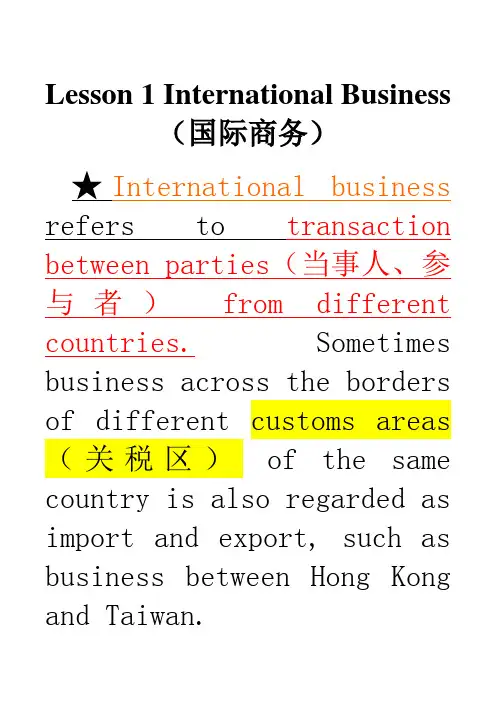
Lesson 1 International Business(国际商务)★International business refers to transaction between parties(当事人、参与者)from different countries.Sometimes business across the borders of different customs areas (关税区)of the same country is also regarded as import and export, such as business between Hong Kong and Taiwan.International business involves more factors and thus is more complicated than domestic business. The followings(下列各项) are some major differences between the two:★ 1. The countries involved often have different legal systems(不同的法律体系), and one or more parties will have to adjust themselves to operate in compliance with(遵照、遵从) the foreign law.2. Different countries usually use different currencies(不同的货币) and the parties will have to decide which currency to use and do everything necessary as regards(关于) conversion (兑换) etc. Uncertainties and even risks are often involved in the use of a foreign currency.3.including language, customs,traditions, religion, value, behavior etc. often constitute challenges and even traps for people engaged in international business. 4. Countries vary in natural and economic conditions and may have different policies towards foreign trade and investment, making international business more complex than domestic business.With the development ofeconomic globalization(经济全球化),few people or companies can completely stay away from(置身于外)international business. Some knowledge in this respect(方面) is necessary both for the benefit of enterprises and personal advancement(个人进步).International business first took the form of commodity trade(商品贸易),.(即)exporting andimporting goods produced or manufactured in one country for consumption or resale(消费或转售) in another. This form of trade is also referred to as(被称为)visible trade(有形贸易). Later a different kind of trade in the form of transportation, communication, banking, insurance, consulting(咨询), information(信息业) etc. gradually became more andmore important. This type of trade is called invisible trade(无形贸易). Today, the contribution of service industries(服务业) of the developed countries constitutes over 60% of their gross domestic products(国内生产总值)and account for(占…) an increasing proportion of world trade. ★Another important form of international business is supplying capital byresidents of one country to another, known ascan be classified into two categories. The first kind of investments, foreign direct investments(外国直接投资)or FDI for short is made for returns(回报)through controlling the enterprises or assets invested in in a host country(东道国).The host country is a foreigncountry where the investor operates, while the country where the headquarters of investor is located is called the home country(投资国). The second kind of investment, portfolio investment(证券投资), refers to purchases of foreign financial assets(金融资产) for a purpose other than controlling.Such financial assets may be stocks(股票), bonds(债券)or certificate of deposit(大额存单). Stocks are also called capital stocks or bonds(股本或股份).★Bonds are papers issued by a government or a firm with promise to pay back the money lent or invested together with interest. The maturity period(到期时间)of a bond is at least one year, often longer, for example five, or even ten years. Certificates of deposit generally involve large amounts, say 25thousand US dollars.★Besides trade and investment, international licensing(国际许可)and franchising(特许经营) are sometimes taken as a means of entering a foreign market. In licensing, a firm leases(出租)the right to use its intellectual property(知识产权) to a firm in another country. Such intellectual property may be trademarks (商标), brand names(品牌),patents(专利), copyrights (版权) or technology(技术). Firms choose licensing is because they don’t have to make cash payment to start business, and can simply receive income in the form of royalty(知识产权/专利使用费). Besides, they can benefit from locational advantages of foreign operation(当地经营优势) without any obligation in ownership or management. Theuse of licensing is particularly encouraged by high customs duty(关税) and non-tariff barriers(非关税壁垒) on the part of the host country. However it is not advisable to use licensing agreement in countries with weak intellectual property protection(知识产权保护)since the licensor(许可方)may have difficulty in enforcing licensing agreement(执行许可协议).Franchising can be regarded as a special form of licensing. Under franchising, a firm, called the franchisee (特许使用方), is allowed to operate in the name of another, called the franchiser(特许授予方) who provides the former with trademarks, brand names, logos(公司标志), and operating techniques(经营技巧) for royalty(特许使用费). In comparison with therelation between the licenser(许可授予方) and the licensee(许可使用方), the franchiser has more control over and provides more support for the franchisee.★The franchiser can develop internationally and gain access to useful information about the local market with little risk and cost, and the franchisee can easily get into a businesswith established(已获认可的)products or services. Franchising is fairly popular especially in hotel and restaurant business. Other forms for participating in international business are management contract(管理合同), contract manufacturing (生产合同), and turnkey project(“交钥匙”工程). Under a management contract, one company offersmanagerial or other specialized services to another within a particular period for a flat payment(固定费用) or a percentage of the relevant business volume(相关业务总价值). ★Sometimes bonuses(分红)based on profitability or sales growth are also specialized (注明) in management contracts. When a government forbids foreign ownership in certainindustries it considers to be of strategic importance but lacks the expertise for operation, management contracts may be a practical (切实可行的)choices enabling a foreign company to operate in the industry without owning the assets. By contract manufacturing, a firm can concentrate on their strongest part in the value chain(价值链), e. g. marketing, while contractingwith foreign companies for the manufacture of their products. Such firms can reduce the amount of their resources devoted to manufacture and benefit from location advantages(当地优势) from production in host counties. ★However, loss of control over the producing process may give rise to(产生) problems in respect of quality and time of delivery (交货期).For an international turnkey project, a firm signs a contract with a foreign purchaser and undertakes all the designing, contracting and facility equipping before handing it over to the latter upon completion.Such projects are often large and complex and take a long period to complete. Payment for a turnkey project may be made at a fixed total price or on a cost plus basis(在实际成本之外收取一定费用). The latter way of payment shifts the burden of possible additional cost over the original budget onto the purchaser.★BOT(建设、经营、移交)is a popular variant of the turnkey project where B stands for build, O for operate and T for transfer. For a BOT project, a firm operates a facility for a period of time after buildingit up before finally transferring it to a foreign company. Making profit from operating the project for a period is the major difference between BOT and the common turnkey project. Needless to say, the contractor has to bear the financial and other risks that may occur in the period of operation.。
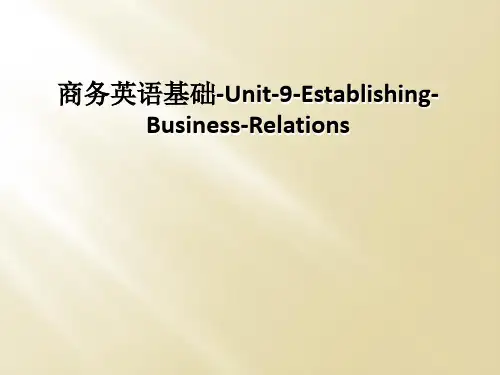
The bulk of (most of)international trade is done in the general mode of buying and selling of goods and services by means of money and the market. Under specific conditions, however, special modes of transactions may be adopted (used) to better realize one’s business purposes. Among them, counter trade and its variants (different forms) are perhaps the most popular modes of trade.Counter trade is a peculiar form of transaction allegedly (据说) popular in less developed countries and in centrally planned economies(中央计划型经济). It has become the generic term to describe a set of cross-border contracts that link a seller’s exports to imports from the buyer, and it is often associated with policy objectives of relevant economies like dealing with foreign exchange shortages and promotion of exports(扩大出口).MethodologyMathematicsphotographThe terminology counter trade employed (used) today can be traced to(date back) the pre-World War II years when normal trade relationswere breaking down (Great Depression). Following German hyperinflation,competitive devaluations (竞争性贬值)and protectionism meant a global collapse in trade and in international financial and banking markets. Unwilling to see Germany cut off from its traditional raw material supplies in the Balkans(巴尔干地区), the Reichsbank agreed to the establishment of a clearing system (清算系统)that settled(结算)only net positions (实际头寸)- and only once a year - a measure that permitted traditional trade flowsbetween Germany and the Balkans to continue. These arrangements were called compensation trade. Another term used in the context of such bilateral clearing operations was “counter trade”. During and after World War II, when financial markets were in disarray(in disorder), Britain used similar bilateral arrangements, as did Western Europe when setting up the European Payment Union. Subsequently (later) the countries of centrally planned economies copied such clearing systems and used them among themselves and also in tradewith neighboring countries like Finland. Conceptually, all these arrangements are trade credit accounts (贸易信贷往来账户) between familiar trading partners exchanging unrelated goods.In the 1970s and 1980s counter trade was different from the old practice although some similarities(likeliness)remained. Current counter trade partners are not necessarily familiar partners and goods exchanged are sometimes vertically related. Current counter trade can be categorized as follows: Barter(易货贸易): The directexchange of goods and services which is completed in a short period of time, e. g., an exchange of frozen lamb from New Zealand for Iran crude oil.Counter purchase(互购贸易;反向购买): The assumption(assume 承担)by an exporter of a transferable obligation through separate but linked contract to accept as full or partial payment goods and services from the importer or importing country. The contract is usually stipulated to be fulfilled within a given period of time, e. g. , 5 years, and the goods or servicesreceived in return are usually pre-specified in a list and are subject to availability and changes made by the original importing country. In essence, then, counter purchase is an inter-temporal direct exchange of goods and services. For example, in 1977 V olkswagen sold 10,000 cars to the former East Germany and agreed to purchase goods from a list set up by the importer over the next 2 years, up to the value of the cars sold to the former East Germany.Buyback:(回购)An agreement by an exporter of plant and equipment(成套装置和设备)to take back in the future part of the output(产品)produced by these goods as full or partial payment. The important difference between counter purchase and buyback is that in buyback the goods and services taken back(buy back)are tied to (捆绑) the original goods exported whereas that is not the case in counter purchase. Another important difference is that a buyback deal usually stretches over (cover; extend 延伸) a longer period of time (as long as 15 to 20 years) than a counter purchase deal. For instance, the Xerox Corporation sold to Chinathe plant and technology for the production of low-volume photocopying machines, and contractually committed to repurchase a very large portion of the photocopy machines produced in the Chinese plant.The intriguing (interesting) features common to barter, counter purchase, and buyback is “bundling (捆绑)”: the exchanges of good s and services are bundled together (the exchanges are implemented either concurrently同时or inter-temporally不同时). In normal market transaction buying andselling of goods and services is unbundled (不捆绑), an arrangement made possible by the use of money and the “market” as an institution (手段). Thus, an individual can sell goods and services to obtain monetary income and can then use the income for other desired goods and services. Such unbundling greatly facilitates(便利;促进)transaction and allows more efficient economic exchanges.While counter trade does not represent an extreme form of bundling, and money as a unit of account(记账单位)is not totallybypassed - in many counter trade deals, only a fraction of (a small part of) the initial (最初的) purchase is paid for in goods and services - the question remains why a significant (quite big)part of the buying and selling of goods and services should be bundled together.The impression one gets is that bundled trade takes place where the market institution(system) is imperfect. It can be said to generally take place between mature market economies and economies with a less sophisticated(mature)market system. Under such circumstancethere are several presumed (被公认的) advantages in counter trade:1.Counter trade is implemented (carry out) because it helps a country to deal with foreign exchange shortages.2.Counter trade can be used to promote exports.3.Counter trade can be used to reduce uncertainty regarding export receipts. (income, earnings)4.Counter trade is used to bypas s (避开) an international price agreement like, for example, that of OPEC (cartel).5.Counter trade may help thosenations with serious debt problems (debtor nation 债务国)to continue to import goods while, in effect, conceal ing (隐瞒) export earnings from creditors (债权人).However, counter trade can be very risky business. By conceal ing the real prices and costs of transactions it may conceal and help perpetuate(使永久存在)economic inefficiencies in the market place. Companies may suffer losses because they could not get rid of (sell)products of poor quality. Finally, counter trade may be considered as a form ofprotectionism.Among other modes of trade are processing trade, consignment, leasing trade, agency etc.。